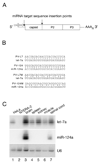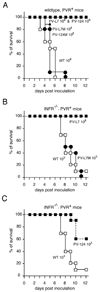Harnessing endogenous miRNAs to control virus tissue tropism as a strategy for developing attenuated virus vaccines
- PMID: 18779050
- PMCID: PMC2605097
- DOI: 10.1016/j.chom.2008.08.003
Harnessing endogenous miRNAs to control virus tissue tropism as a strategy for developing attenuated virus vaccines
Abstract
Live attenuated vaccines remain the safest, most cost-effective intervention against viral infections. Because live vaccine strains are generated empirically and the basis for attenuation is usually ill defined, many important viruses lack an efficient live vaccine. Here, we present a general strategy for the rational design of safe and effective live vaccines that harnesses the microRNA-based gene-silencing machinery to control viral replication. Using poliovirus as a model, we demonstrate that insertion of small miRNA homology sequences into a viral genome can restrict its tissue tropism, thereby preventing pathogenicity and yielding an attenuated viral strain. Poliovirus strains engineered to become targets of neuronal-specific miRNAs lost their ability to replicate in the central nervous system, leading to significant attenuation of neurovirulence in infected animals. Importantly, these viruses retained the ability to replicate in nonneuronal tissues. As a result, these engineered miRNA-regulated viruses elicited strong protective immunity in mice without producing disease.
Figures





References
-
- Abrahante JE, Daul AL, Li M, Volk ML, Tennessen JM, Miller EA, Rougvie AE. The Caenorhabditis elegans hunchback-like gene lin-57/hbl-1 controls developmental time and is regulated by microRNAs. Dev Cell. 2003;4:625–637. - PubMed
-
- Andino R, Boddeker N, Silvera D, Gamarnik AV. Intracellular determinants of picornavirus replication. Trends Microbiol. 1999;7:76–82. - PubMed
-
- Graham Barney S, James E Crowe J. Immunization against viral diseases. Vol Volume 1. Philadelphia: Lippincott Williams and Wilkins, a Wolters Kluwer Business; 2007.
-
- Bartel DP. MicroRNAs: genomics, biogenesis, mechanism, and function. Cell. 2004;116:281–297. - PubMed
Publication types
MeSH terms
Substances
Grants and funding
LinkOut - more resources
Full Text Sources
Other Literature Sources
Medical
Research Materials

